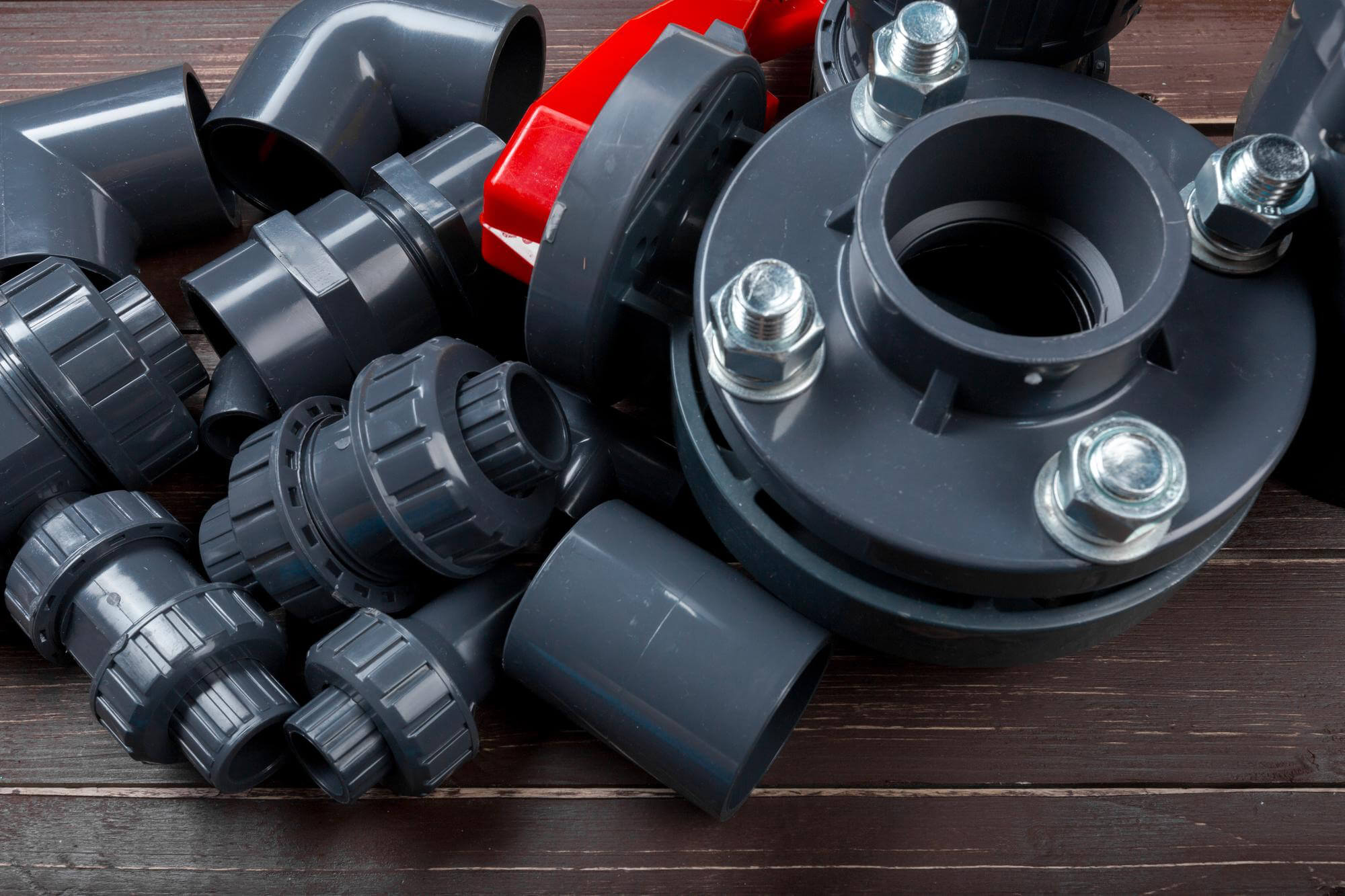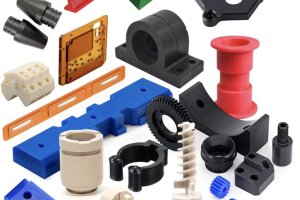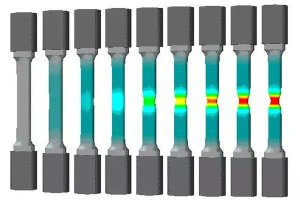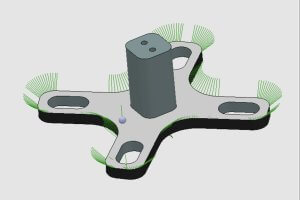Introduction
PVC flanges are essential components in various industries, including water treatment, chemical processing, agriculture, and construction. They serve as connectors that ensure the secure joining of pipes, valves, and equipment in piping systems. While standard PVC flanges are readily available, many applications require customized PVC flanges to meet specific requirements, such as unique dimensions, configurations, and enhanced durability.
CNC (Computer Numerical Control) technology has become a critical tool for achieving precision in the production of these custom PVC flanges. CNC machines allow for precise cutting, drilling, and shaping of PVC materials, ensuring that each flange meets the exact specifications needed for the application. This technology offers unparalleled flexibility, enabling manufacturers to quickly adapt designs and produce high-quality components efficiently.
This article explores the use of CNC technology in customizing PVC flanges, detailing the applications, benefits, and processes involved. Whether you are in the industrial, agricultural, or construction sector, understanding how CNC technology can optimize PVC flange production is crucial for improving system performance and reliability.
Common Applications of PVC Flanges
PVC flanges have widespread applications in various industries. Here are some examples of their uses:
| Industry | Application | Function |
|---|---|---|
| Water Treatment | Connecting water pipes | Ensures leak-proof connections in water distribution and treatment systems. |
| Chemical Industry | Chemical pipeline fittings | Resistant to corrosion, suitable for conveying chemicals. |
| Agriculture | Irrigation system connections | Provides flexibility in agricultural water distribution systems. |
| Construction | Ventilation and exhaust systems | Connects ducts and exhaust components for efficient airflow. |
| HVAC Systems | Heating, ventilation, and cooling | Allows secure attachment of various components for thermal regulation. |
| Food Processing | Fluid transfer systems | Maintains sanitary conditions for transporting fluids and ingredients. |
Specific Customization Needs in Different Industries
- Water Treatment:
- In water treatment systems, flanges must be custom-designed to fit various pipe sizes and layouts, ensuring a secure and leak-proof connection. Custom PVC flanges are also used to accommodate specific valve and pump connections.
- Chemical Industry:
- Custom PVC flanges are essential for chemical processing applications where resistance to corrosion and chemical compatibility are critical. CNC technology enables precise machining to create flanges that match the exact specifications required for chemical systems.
- Agriculture:
- Agricultural irrigation systems often require flanges that can be adapted to different pipe configurations and water flow requirements. Custom CNC-machined PVC flanges provide the flexibility needed to optimize water distribution.
- Construction and HVAC Systems:
- In building construction, particularly in HVAC systems, custom PVC flanges connect ventilation ducts and components. CNC technology ensures these flanges are manufactured to precise dimensions for efficient installation and performance.
Understanding the various applications of PVC flanges helps highlight the importance of customization in meeting industry-specific needs.
Why Choose CNC Machining for Custom PVC Flanges?
CNC machining is an ideal solution for producing custom PVC flanges due to its precision, flexibility, and efficiency. Here are the key advantages:
- Precision and Accuracy:
- CNC machines use computer-aided design (CAD) files to precisely cut and shape PVC flanges, ensuring exact dimensions and consistent quality. This level of precision is essential for components that must fit perfectly within piping systems.
- Flexibility:
- CNC machining offers flexibility in design and production, allowing for quick adjustments based on client requirements. Whether modifying dimensions or hole patterns, CNC technology can accommodate changes with minimal delay.
- Efficiency:
- CNC machines operate autonomously once programmed, reducing labor costs and increasing production speed. This efficiency is particularly valuable when manufacturing custom flanges in larger quantities.
Comparison Between CNC and Traditional Manufacturing Methods
| Method | Advantages | Disadvantages |
|---|---|---|
| CNC Machining | High precision, flexible design, quick adjustments | Higher initial setup costs |
| Traditional Molding | Cost-effective for mass production, low material waste | Limited design flexibility, requires new molds for changes |
CNC machining surpasses traditional methods, especially when dealing with small to medium batches of custom PVC flanges. While traditional molding is effective for mass production, CNC’s precision and adaptability make it the preferred choice for bespoke designs and rapid prototyping.
How Does CNC Achieve High-Precision Machining for Custom PVC Flanges?
CNC technology offers various techniques for machining PVC flanges with high precision:
- Cutting and Shaping:
- CNC routers and mills are used to cut PVC material into specific shapes and sizes. The CAD file guides the machine to ensure the flange dimensions are exact, resulting in accurate, repeatable outcomes.
- Drilling and Grooving:
- CNC machines also drill holes and create grooves according to the flange’s specifications. This ensures that all holes align perfectly for bolts, making the flange suitable for easy assembly.
- Multi-Axis Machining:
- Advanced CNC machines with multi-axis capabilities can handle more complex flange designs, such as angled or asymmetrical shapes. This flexibility is crucial for industries that need highly specific configurations.
| CNC Technique | Application | Benefits |
|---|---|---|
| Cutting and Shaping | Basic flange formation | High precision, consistency |
| Drilling | Creating bolt holes and connections | Ensures alignment and fit |
| Grooving | Adding channels for sealing | Improves connection tightness |
| Multi-Axis Machining | Complex, non-standard flanges | Enables custom, intricate designs |
CNC technology’s versatility in these techniques makes it possible to create customized PVC flanges that meet the exact needs of various industries.
Design and Material Selection for Custom PVC Flanges
Designing custom PVC flanges requires a thorough understanding of the intended application and specific industry requirements. This section explores the key factors involved in the design process and the selection of appropriate PVC materials for flange customization.
Key Factors to Consider When Designing PVC Flanges
- Flange Size and Dimensions:
- The size of the flange must align with the piping system’s specifications. Factors such as outer diameter, bolt circle diameter, and number of bolt holes need precise calculation to ensure a proper fit and secure connection.
- Pressure Rating:
- Depending on the application, the PVC flange must withstand different pressure levels. For instance, flanges used in high-pressure water systems or chemical pipelines need to be designed with reinforced structures to prevent failure.
- Hole Configuration:
- The hole pattern of a flange is critical for aligning with other components in the piping system. Customization might involve varying the number of bolt holes, their diameter, and placement to suit specific requirements.
- Temperature Resistance:
- In applications involving temperature variations (e.g., HVAC systems or chemical processing), it’s essential to design flanges that accommodate thermal expansion without losing structural integrity.
- Sealing and Tightness:
- Proper sealing is essential to prevent leaks in piping systems. CNC machining allows for precise grooving and surface finishing, which ensures the flange can accommodate gaskets or seals, enhancing the connection’s reliability.
Characteristics of Different PVC Materials for Flange Customization
PVC materials come in various types, each suited for different applications. The table below provides a comparison of common PVC materials and their properties.
| PVC Type | Properties | Advantages | Applications |
|---|---|---|---|
| Standard PVC | Moderate strength, low cost | Easy to machine, cost-effective | General plumbing, irrigation systems |
| CPVC (Chlorinated PVC) | High temperature resistance, chemical resistance | Suitable for hot water and chemical pipes | Chemical processing, hot water systems |
| UPVC (Unplasticized PVC) | Rigid, strong, UV-resistant | Long-lasting, resistant to weathering | Outdoor piping, construction |
| PVC-O (Oriented PVC) | High impact resistance, flexible | Lightweight, easy to install | Irrigation systems, underground pipes |
- Standard PVC:
- This is the most common type, suitable for general applications like water distribution and drainage. Its ease of machining makes it ideal for quick customization using CNC.
- CPVC:
- CPVC is modified to withstand higher temperatures and has improved chemical resistance, making it suitable for chemical processing and hot water systems. CNC machining ensures precise dimensions that maintain CPVC’s structural integrity under heat stress.
- UPVC:
- This type of PVC is particularly rigid and durable, with resistance to UV radiation. It’s often used in outdoor applications like construction and drainage systems. CNC machining can be utilized to create customized flanges that maintain UPVC’s rigidity while fitting specific outdoor requirements.
- PVC-O:
- Oriented PVC offers flexibility and high impact resistance, making it perfect for irrigation systems and underground pipes where durability and adaptability are essential. CNC technology can shape PVC-O flanges to match these demanding environments.
By choosing the right type of PVC material and carefully designing the flange’s features, manufacturers can create custom components that perform reliably across a wide range of applications.
Cost Analysis and Optimization Strategies for CNC Machining PVC Flanges
Cost considerations play a crucial role in the production of custom PVC flanges. This section examines the factors influencing costs and offers strategies to optimize expenses while maintaining quality and precision.
Factors Affecting the Cost of Custom PVC Flanges
- Material Costs:
- The type of PVC material chosen impacts costs significantly. Standard PVC is generally more economical, while specialized variants like CPVC or UPVC may be more expensive due to their enhanced properties.
- Design Complexity:
- More complex flange designs, such as those requiring intricate hole patterns, grooves, or multi-axis machining, tend to be more costly. These designs increase machining time and may require specialized tooling.
- Production Volume:
- Production volume directly affects the cost per unit. Higher volumes typically reduce the cost per flange due to economies of scale, while smaller batches or one-off prototypes will have a higher cost per unit due to setup time and tooling requirements.
- Post-Processing Requirements:
- Additional processes like surface polishing, grooving for seals, or specific coatings to enhance durability will add to the overall production cost. CNC technology allows these post-processing steps to be integrated efficiently, but each additional step increases time and material use.
Cost Optimization Strategies
- Material Optimization:
- Choosing the appropriate PVC material for the specific application can help control costs. For example, using standard PVC where extreme temperature or chemical resistance is not required can be a cost-effective approach.
- Batch Production Planning:
- Planning production in batches, even for custom orders, can significantly reduce costs. Grouping similar designs or orders together allows manufacturers to minimize setup times and maximize machine utilization.
- Design for Manufacturability (DFM):
- Collaborating with engineers during the design phase to simplify features and avoid unnecessary complexities can reduce the machining time. By aligning designs with CNC capabilities, manufacturers can streamline production while maintaining functionality.
- Tool Path Optimization:
- Efficient CNC programming and tool path optimization can minimize machining time and reduce tool wear, saving both time and costs. Using high-efficiency machining techniques ensures that the production process remains economical.
Cost Comparison Table for Custom PVC Flanges
| Cost Factor | Low-Cost Scenario | High-Cost Scenario |
|---|---|---|
| Material Type | Standard PVC | CPVC or UPVC |
| Design Complexity | Simple geometry, standard hole patterns | Complex features, tight tolerances |
| Production Volume | High-volume batch | Low-volume or prototype |
| Post-Processing | Minimal (basic drilling and cutting) | Extensive (grooving, sealing, coatings) |
| Machining Time | Short cycle with optimized tool paths | Long cycle for intricate designs |
This table highlights how various factors can influence the total cost of custom PVC flanges. Understanding these elements enables manufacturers and clients to make informed decisions that balance quality, functionality, and budget.
Case Studies: Successful Applications of Custom PVC Flanges in Various Industries
Custom PVC flanges play a crucial role in enhancing system performance and reliability across different industries. This section provides real-world examples of how CNC technology has been successfully applied to meet specific industry needs.
Case Study 1: Water Treatment System Upgrades
- Challenge: A water treatment facility needed to upgrade its piping system with flanges capable of accommodating larger pipes and newer filtration units.
- Solution: Using CNC machining, custom PVC flanges were designed with precise hole patterns and dimensions to match the new components. The flexibility of CNC technology allowed the flanges to be produced quickly, ensuring minimal downtime during installation.
- Outcome: The custom flanges provided a secure, leak-proof connection, enhancing the efficiency and reliability of the water treatment process. The facility reported a 15% increase in operational efficiency due to the improved fit and flow management.
Case Study 2: Chemical Processing Plant Retrofitting
- Challenge: A chemical plant required flanges that could withstand high-temperature chemical reactions while fitting existing pipe layouts.
- Solution: CNC technology was used to produce CPVC flanges with precise grooves for sealing and optimized dimensions to ensure compatibility with the plant’s systems. The ability to use high-temperature-resistant materials and customize the flange design ensured that the flanges met safety standards.
- Outcome: The custom flanges increased the plant’s safety rating and extended the service life of the piping system. Maintenance costs were reduced by 25%, and the plant experienced fewer incidents of leakage.
Case Study 3: Agricultural Irrigation System Enhancement
- Challenge: An agricultural farm needed flanges that could be adapted to various pipe sizes and configurations for an efficient water distribution system.
- Solution: CNC-machined PVC-O flanges were created to provide a flexible, lightweight solution that could easily be installed and modified as needed. CNC machining ensured that all bolt holes and grooves were precisely aligned for quick assembly.
- Outcome: The farm reported a 20% increase in water usage efficiency and a 30% reduction in installation time. The customized flanges contributed to improved crop yields due to better irrigation management.
These case studies illustrate the diverse applications and benefits of using CNC technology for custom PVC flanges. By tailoring solutions to specific industry needs, CNC technology ensures that PVC flanges meet performance, safety, and efficiency standards.
Conclusion
For businesses and industries looking for high-quality, customized PVC flanges, CNC technology offers the best solution. Investing in CNC machining for flange customization not only ensures precision and reliability but also provides the flexibility needed to adapt to diverse industry requirements.
FAQs
To provide further insights and address common concerns related to the customization of PVC flanges using CNC technology, here are some frequently asked questions:
- What is the advantage of using CNC technology for custom PVC flanges?
CNC technology offers precise, repeatable, and efficient production processes that are essential for creating custom flanges that meet exact specifications. The flexibility of CNC machining also allows for rapid adjustments and prototyping. - How long does it take to produce a custom PVC flange using CNC machining?
The production time depends on the complexity of the design and the number of flanges needed. Simple designs can be produced within a few hours, while more intricate flanges may take a day or more, especially when multiple adjustments or post-processing steps are required. - What types of PVC materials can be used for CNC-machined flanges?
Common types include standard PVC, CPVC, UPVC, and PVC-O. The choice of material depends on the application’s requirements, such as temperature resistance, rigidity, or chemical compatibility. - Can CNC machining handle small batch production for PVC flanges?
Yes, CNC machining is particularly effective for small batch and custom orders. Unlike traditional mold-based methods, CNC does not require new molds for each design, making it a cost-effective option for limited production runs. - What is the cost difference between CNC machining and traditional molding for PVC flanges?
CNC machining typically has a higher initial setup cost but becomes more economical for small to medium-sized batches and prototypes due to the flexibility and precision it offers. Traditional molding is more cost-effective for large-scale production but lacks the customization capabilities and speed of CNC. - How do I choose the right PVC material for my custom flange?
The choice of PVC material should depend on the specific conditions of use, such as exposure to chemicals, temperature variations, and outdoor environments. CPVC is suitable for high-temperature or chemical applications, while UPVC is ideal for outdoor use due to its UV resistance. - Can CNC-machined PVC flanges be customized for complex designs?
Yes, CNC technology is highly adaptable and can handle complex designs, including multi-axis configurations. This allows for intricate shapes and customized hole patterns that standard flanges cannot achieve. - Is CNC machining suitable for producing large quantities of PVC flanges?
While CNC machining is excellent for custom and small batch production, it may not be the most cost-effective solution for large-scale manufacturing due to its higher setup costs. For large volumes, traditional molding might be more economical. - What quality control measures are used in CNC machining for PVC flanges?
CNC machining incorporates various quality control methods, such as using CAD verification, in-process monitoring, and post-production inspections to ensure that each flange meets the specified standards.
Other Articles You Might Enjoy
- Exploration of Flange CNC Machining Technology
Flanges, as crucial mechanical connection components, are widely used in various pipelines, containers, valves, and other equipment, ensuring stable connections and reliable sealing. In modern manufacturing, particularly in industries such…
- Elevating Precision Standards through Chamfer in CNC Machining
1. Introduction: The Pursuit of Unparalleled Precision In the realm of CNC machining, precision is paramount. This section introduces the article by exploring the significance of precision in manufacturing and…
- Precision Prowess: Unveiling the Advantages of China CNC Machining
1. Introduction: The Role of Precision in Manufacturing Excellence In this introductory section, we delve into the critical role that precision plays in manufacturing and set the stage for an…
- Precision Metalwork: Lightweight CNC Machining and Chrome Removal( cnc machine tools Norman)
CNC machining, a dominant force in the world of manufacturing, is intricately involved with creating complex parts out of lightweight metal, as well as removing chrome from metal components. This…
- How to Choose a CNC Company for Precision Stainless Steel Flange Machining?
Selecting the right CNC machining company is crucial for achieving high-quality, precision stainless steel flanges. This detailed guide explores the essential factors to consider in this decision-making process, ensuring that…
- Revolutionizing CNC Machining for Complex Aerospace Assemblies
Introduction to CNC Machining in Aerospace Assemblies Computer Numerical Control (CNC) machining represents a significant technological development playing a notable role in the creation of complex aerospace assemblies. CNC machining…









